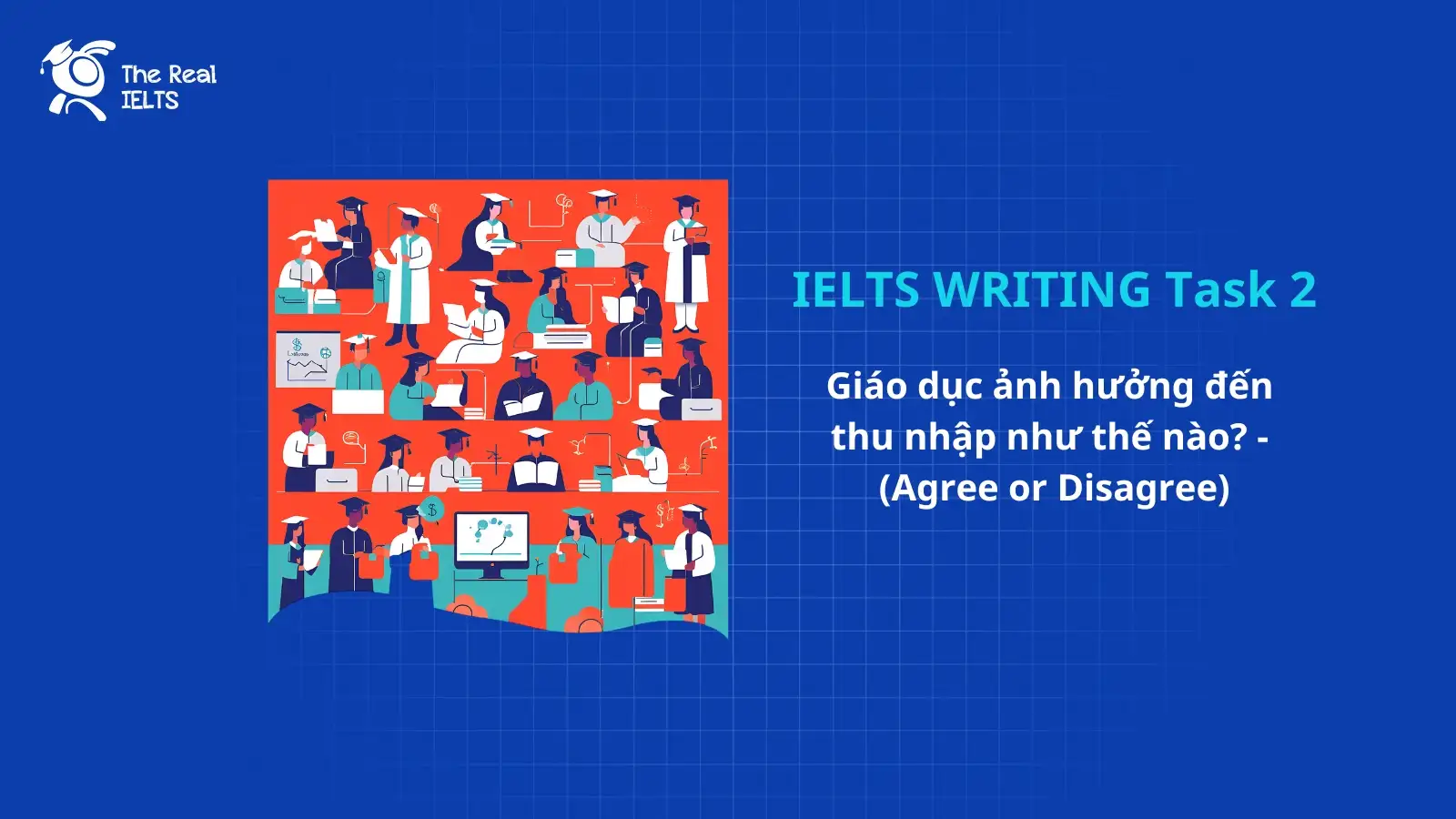Chủ đề Advertising là chủ đề khi thi IELTS được nhiều lần đưa ra nhằm thử thách khả năng viết của thí sinh đồng thời cũng là để biết xem thí sinh có đủ khả năng tiếp thu kiến thức khi học đại học ở nước ngoài hay không.
Đọc thêm các chủ đề về Writing nhé.
Các dạng câu hỏi khi gặp chủ đề Advertising
Khi gặp dạng câu hỏi có chủ đề Advertising thì chúng ta hay gặp câu hỏi dạng như sau:
| In your opinion, does advertising have a positive or negative impact on society today? Why? | Theo bạn, quảng cáo có ảnh hưởng tích cực hay tiêu cực đối với xã hội hiện nay? Vì sao? |
| Is spending a lot of money on advertising a smart strategy for a company? | Đối với một công ty, việc chi tiêu nhiều tiền vào quảng cáo có phải là một chiến lược thông minh hay không? |
| What are the positive or negative effects of advertising on social media platforms like Facebook and Instagram for users? | Quảng cáo trên mạng xã hội như Facebook và Instagram có những ảnh hưởng tích cực hoặc tiêu cực gì đối với người dùng? |
| Do you think banning tobacco and alcohol advertising is necessary? Why? | Theo bạn, liệu việc cấm quảng cáo thuốc lá và rượu bia là cần thiết hay không? Vì sao? |
| How influential are television and internet advertisements in influencing consumer purchasing decisions? | Mức độ ảnh hưởng của quảng cáo trên truyền hình và trên internet đối với việc quyết định mua sắm của người tiêu dùng là như thế nào? |
| In today’s competitive business environment, is advertising the most important factor in attracting customers? | Trong môi trường kinh doanh cạnh tranh ngày nay, liệu quảng cáo có phải là yếu tố quan trọng nhất để thu hút khách hàng không? |
| Do advertisements using gender images and messages have a positive or negative impact on consumers? | Quảng cáo sản phẩm sử dụng hình ảnh và thông điệp giới tính có ảnh hưởng tích cực hay tiêu cực đối với người tiêu dùng? |
| Some argue that advertising creates issues with self-esteem. Do you agree? Why? | Một số người cho rằng quảng cáo gây ra vấn đề về tự hình dung của họ. Bạn đồng ý hay không? Tại sao? |
| How do advertisements related to health and body image affect both men and women? | Các quảng cáo liên quan đến sức khỏe và thân hình thường có ảnh hưởng như thế nào đối với cả nam và nữ? |
| Do you think there should be stricter regulations on advertising content and mediums? Why? | Theo bạn, liệu có nên có các quy định nghiêm ngặt hơn về nội dung và phương tiện quảng cáo không? Vì sao? |
Lập dàn ý cho các câu hỏi đề tập viết
In your opinion, does advertising have a positive or negative impact on society today? Why?
Viết outline:
I. Introduction
A. Definition of advertising
B. Mention the significance of advertising in today’s society
II. Positive Impacts of Advertising
A. Raises awareness about products and services
B. Stimulates economic growth and drives consumption
C. Supports media and content creation
D. Fosters healthy competition among businesses
III. Negative Impacts of Advertising
A. Promotes materialism and consumerism
B. Exploits insecurities and manipulates emotions
C. Encourages unhealthy habits and lifestyles
D. Contributes to environmental degradation
IV. Analysis of Overall Impact
A. Balancing the positive and negative impacts
B. Consideration of diverse perspectives and contexts
C. The role of regulation and ethical advertising practices
V. Personal Opinion
A. Statement of personal stance on the impact of advertising
B. Justification based on arguments presented
C. Acknowledgment of complexities and nuances in the debate
VI. Conclusion
A. Recap of key points discussed
B. Emphasis on the importance of critical evaluation of advertising’s role in society
C. Call for responsible advertising practices and informed consumer choices.
Từ vựng và cụm từ vựng để viết bài theo như outline trên
- Advertisement / Advertising: Promotion of products, services, or ideas through various media channels.
- Positive impact: Favorable effects or benefits.
- Negative impact: Adverse effects or drawbacks.
- Society: The community of people living in a particular region or country, considered as a whole.
- Awareness: Understanding or knowledge about something.
- Economic growth: Increase in the production and consumption of goods and services within an economy.
- Consumption: Act of using goods or services.
- Media: Channels of communication, such as television, radio, print, and digital platforms.
- Content creation: Development of material for various media platforms, including articles, videos, and social media posts.
- Competition: Rivalry among businesses or individuals for market share or resources.
- Materialism: Emphasis on material possessions and wealth as a measure of success or happiness.
- Consumerism: Culture or ideology that promotes excessive consumption of goods and services.
- Exploitation: Utilization of someone or something in a way that is unfair or unethical.
- Manipulation: Influencing or controlling someone or something in a clever or dishonest way.
- Insecurities: Feelings of uncertainty or inadequacy.
- Environmental degradation: Decline in the quality of the natural environment due to human activities.
- Regulation: Rules or laws established by authorities to govern behavior or activities.
- Ethics: Moral principles that guide behavior and decision-making.
- Responsible: Acting in a way that considers the consequences of one’s actions and their impact on others.
- Informed: Having knowledge or understanding based on reliable information.
Viết đoạn văn sau khi đã chuẩn bị
In my opinion, advertising plays a significant role in today’s society, but its impact can be controversial. Advertisement serves as a powerful tool to raise awareness about products and services, contributing to economic growth by stimulating consumption. Moreover, it supports the media industry by funding content creation. This positive impact fosters healthy competition among businesses, ultimately benefiting consumers. However, it’s crucial to acknowledge the negative impacts as well.
Advertising often promotes materialism and consumerism, leading to an excessive focus on possessions rather than personal well-being. Furthermore, it exploits people’s insecurities and manipulates their emotions to drive sales. This can encourage unhealthy habits and contribute to environmental degradation through increased consumption and waste generation. Therefore, while advertising has its merits, its overall impact on society hinges on responsible practices and ethical considerations, as well as effective regulation to mitigate its negative consequences.
Is spending a lot of money on advertising a smart strategy for a company?
Viết outline:
I. Introduction
A. Explanation of the question: “Is spending a lot of money on advertising a smart strategy for a company?”
B. Thesis statement: While spending a significant amount of money on advertising can yield benefits, it may not always be the most strategic approach for every company.
II. Advantages of spending a lot of money on advertising
A. Increased brand visibility and recognition
B. Ability to reach wider target audiences
C. Potential for increased sales and revenue
D. Competitive advantage over rivals
III. Disadvantages of spending a lot of money on advertising
A. Diminished return on investment (ROI) if not targeted properly
B. Possibility of overspending without significant returns
C. Dependency on advertising rather than focusing on product/service quality
D. Risk of damaging brand reputation if advertising is perceived as excessive or intrusive
IV. Factors influencing the effectiveness of advertising spending
A. Industry and market dynamics
B. Target audience preferences and behavior
C. Competitors’ advertising strategies
D. Available resources and budget constraints
V. Alternative strategies to consider
A. Investing in product/service innovation and quality
B. Leveraging digital marketing channels for cost-effective reach
C. Implementing targeted advertising campaigns based on data analysis
D. Focusing on building organic brand loyalty through customer engagement and satisfaction
VI. Conclusion
A. Recap of the argument
B. Emphasis on the need for a balanced approach to advertising spending
C. Recommendation for companies to carefully evaluate their specific circumstances and objectives before allocating resources to advertising.
Từ vựng và cụm từ vựng để viết bài theo như outline trên
- Advertising: Promotional activities aimed at increasing the visibility or sales of a product or service.
- Strategy: A plan of action designed to achieve a particular goal or objective.
- Company: A business entity engaged in commercial, industrial, or professional activities.
- Spending: The act of using money to purchase goods or services.
- Smart: Intelligent or wise; characterized by good judgment.
- Benefit: An advantage or positive outcome gained from a particular action or situation.
- Visibility: The degree to which something is visible or noticeable.
- Recognition: The acknowledgment or identification of something or someone.
- Target audience: The specific group of individuals or demographics that a marketing campaign is designed to reach.
- Revenue: Income generated from the sale of goods or services.
- Competitive advantage: A unique position or attribute that gives a company an edge over its rivals.
- Return on investment (ROI): The ratio of net profit to the initial cost of investment, often used to measure the profitability of an advertising campaign.
- Overspending: Exceeding the budget or spending more money than is necessary or advisable.
- Dependency: Reliance on something for support or sustenance.
- Quality: The standard of excellence or superiority of a product or service.
- Brand reputation: The perception or esteem associated with a particular brand or company.
- Effectiveness: The degree to which something is successful in producing a desired result.
- Industry: A particular branch or sector of economic activity.
- Market dynamics: The forces and factors that influence the behavior of buyers and sellers in a market.
- Resources: Assets, funds, or other means that can be used to accomplish a task or objective.
- Budget constraints: Limits on the amount of money that can be spent on a particular activity or project.
- Innovation: The introduction of new ideas, methods, or products.
- Digital marketing: Promotional activities carried out using digital channels such as the internet, social media, and mobile devices.
- Data analysis: The process of examining and interpreting data to uncover useful information or insights.
- Organic: Natural or inherent; occurring spontaneously without artificial aid.
- Loyalty: Faithfulness or allegiance to a person, cause, or brand.
- Customer engagement: Interaction and involvement with customers to build relationships and enhance satisfaction.
- Circumstances: The specific conditions or factors affecting a situation or decision.
- Objective: A goal or purpose that a person or organization is trying to achieve.
- Allocation: The distribution or assignment of resources, such as money or time, to different activities or purposes.
Viết đoạn văn sau khi đã chuẩn bị
Spending a significant amount of money on advertising can be a strategic decision for a company, but it is not always guaranteed to yield positive results. While advertising can enhance visibility and recognition for a company’s brand, it’s essential to carefully evaluate whether this approach aligns with the company’s objectives and resources.
On one hand, investing heavily in advertising can provide several benefits. It can help the company reach a wider target audience, leading to potential increases in revenue and competitive advantage over rivals. Moreover, effective advertising campaigns can enhance brand reputation and create a lasting impression on consumers, ultimately driving sales and fostering brand loyalty.
However, there are also potential drawbacks to consider. Without a proper strategy and targeting, companies may experience diminished return on investment or even overspending, which can strain resources without delivering significant results. Additionally, excessive reliance on advertising could overshadow the importance of focusing on product quality and customer satisfaction, which are crucial for long-term success.
To determine the effectiveness of advertising spending, companies need to assess various factors such as industry dynamics, target audience preferences, and competitors’ strategies. It’s also essential to consider budget constraints and the availability of other resources before allocating funds to advertising.
In light of these considerations, companies may explore alternative strategies alongside advertising. This could include investing in innovation and digital marketing, implementing targeted campaigns based on data analysis, and prioritizing customer engagement and loyalty building.
In conclusion, while spending a lot of money on advertising can be a smart strategy under certain circumstances, it’s crucial for companies to weigh the potential benefits against the risks and explore alternative approaches to achieve their objectives effectively.
What are the positive or negative effects of advertising on social media platforms like Facebook and Instagram for users?
Viết outline:
I. Introduction
A. Definition of advertising on social media platforms
B. Popularity and prevalence of advertising on platforms like Facebook and Instagram
C. Importance of examining its effects on users
II. Positive Effects of Advertising on Social Media Platforms
A. Increased awareness and exposure to products/services
B. Personalized and targeted advertising
C. Opportunities for discovering new products or services
D. Facilitation of consumer engagement and interaction
III. Negative Effects of Advertising on Social Media Platforms
A. Intrusiveness and potential privacy concerns
B. Creation of unrealistic standards and desires
C. Potential for manipulation and misinformation
D. Overwhelming amount of advertisements leading to user fatigue
IV. Impact on User Behavior and Well-being
A. Influence on purchasing decisions
B. Psychological effects on self-esteem and body image
C. Time spent on social media platforms
D. Overall satisfaction and perception of social media experience
V. Conclusion
A. Recap of positive and negative effects
B. Importance of regulating and balancing advertising practices
C. Suggestions for users to navigate social media platforms mindfully
D. Call to further research on the topic and its evolving dynamics
Từ vựng và cụm từ vựng để viết bài theo như outline trên
- Positive Effects:
- Awareness (Nhận thức)
- Exposure (Tiếp cận)
- Personalized (Cá nhân hóa)
- Targeted (Hướng đến mục tiêu)
- Engagement (Tương tác)
- Interaction (Tương tác)
- Opportunities (Cơ hội)
- Discover (Khám phá)
- Negative Effects:
- Intrusiveness (Sự xâm phạm)
- Privacy concerns (Lo ngại về quyền riêng tư)
- Unrealistic standards (Tiêu chuẩn không thực tế)
- Manipulation (Sự thao túng)
- Misinformation (Thông tin sai lệch)
- Fatigue (Mệt mỏi)
- Impact on User Behavior and Well-being:
- Influence (Ảnh hưởng)
- Purchasing decisions (Quyết định mua hàng)
- Self-esteem (Tự trọng)
- Body image (Hình ảnh cơ thể)
- Perception (Nhận thức)
- Satisfaction (Sự hài lòng)
- Mindfully (Cẩn thận, chú ý)
- Conclusion:
- Regulating (Điều chỉnh)
- Balancing (Cân bằng)
- Practices (Thực hành)
- Navigate (Điều hướng)
- Evolving dynamics (Động lực phát triển)
Viết đoạn văn sau khi đã chuẩn bị
Advertising on social media platforms like Facebook and Instagram has both positive and negative effects on users. On the positive side, it significantly enhances user awareness and exposure to various products and services. Through personalized and targeted ads, users are presented with offerings that align with their interests and preferences, creating valuable opportunities to discover new products or services they might not have encountered otherwise. Moreover, advertising facilitates engagement and interaction between users and brands, fostering a sense of community and involvement in the online sphere. However, there are also negative repercussions.
The intrusiveness of ads can raise privacy concerns among users, as their personal data may be used for targeted advertising without their explicit consent. Furthermore, the proliferation of ads can contribute to the formation of unrealistic standards and desires, leading to dissatisfaction and even detrimental effects on self-esteem and body image. Thus, while advertising on social media platforms offers numerous benefits, it’s crucial to navigate these platforms mindfully and advocate for regulating and balancing advertising practices to ensure a positive user experience.
Do you think banning tobacco and alcohol advertising is necessary? Why?
Viết outline:
I. Introduction
A. Briefly state the topic: Banning tobacco and alcohol advertising.
B. Present the stance: The necessity of banning tobacco and alcohol advertising.
II. Health Concerns
A. Highlight the detrimental health effects of tobacco and alcohol consumption.
B. Discuss the role of advertising in promoting these products, potentially leading to increased usage.
C. Emphasize the importance of public health in mitigating these risks.
III. Influence on Youth
A. Explain how advertising can target and influence young people.
B. Discuss the vulnerability of youth to tobacco and alcohol marketing.
C. Illustrate the impact of exposure to such advertisements on underage consumption.
IV. Economic Impact
A. Acknowledge the potential economic repercussions for tobacco and alcohol industries.
B. Consider alternative advertising strategies that don’t promote harmful substances.
C. Discuss long-term benefits for public health and healthcare costs.
V. Ethical Considerations
A. Address the ethical concerns surrounding the promotion of products with known health risks.
B. Discuss the responsibility of advertisers and regulatory bodies in safeguarding public health.
C. Argue for the ethical imperative of prioritizing health over profit.
VI. Conclusion
A. Recap the points supporting the necessity of banning tobacco and alcohol advertising.
B. Reiterate the importance of protecting public health and vulnerable populations.
C. Call for concerted efforts to implement policies aligning with these principles.
Từ vựng và cụm từ vựng để viết bài theo như outline trên
- Introduction
- Briefly: ngắn gọn
- Stance: quan điểm
- Health Concerns
- Detrimental health effects: ảnh hưởng tiêu cực đối với sức khỏe
- Consumption: tiêu thụ
- Promoting: thúc đẩy
- Public health: sức khỏe công cộng
- Mitigating: làm giảm bớt
- Influence on Youth
- Target: mục tiêu
- Vulnerability: sự dễ bị tổn thương
- Underage consumption: tiêu thụ dưới tuổi
- Exposure: tiếp xúc
- Economic Impact
- Repercussions: hậu quả
- Industries: ngành công nghiệp
- Alternative advertising strategies: các chiến lược quảng cáo thay thế
- Public health: sức khỏe công cộng
- Healthcare costs: chi phí chăm sóc sức khỏe
- Ethical Considerations
- Promotion: khuyến mãi
- Health risks: nguy cơ về sức khỏe
- Responsibility: trách nhiệm
- Regulatory bodies: cơ quan quản lý
- Profit: lợi nhuận
- Conclusion
- Recap: tóm lại
- Protecting: bảo vệ
- Vulnerable populations: các nhóm dân số dễ bị tổn thương
- Implement: thực hiện
- Policies: chính sách
Viết bài văn theo outline và cụm từ vựng bên trên
The Necessity of Banning Tobacco and Alcohol Advertising
Introduction: In today’s society, the promotion of harmful substances such as tobacco and alcohol through advertising has become a contentious issue. This essay argues for the necessity of banning tobacco and alcohol advertising, considering its detrimental effects on public health and ethical implications.
Health Concerns: The detrimental health effects of tobacco and alcohol consumption are well-documented. Both substances are associated with a range of diseases, including cancer, cardiovascular diseases, and addiction. By promoting these products, advertising contributes to increased usage and exacerbates the burden on public health systems. Thus, mitigating these risks is imperative to safeguard the well-being of society.
Influence on Youth: Tobacco and alcohol advertising often targets young people, exploiting their vulnerability to persuasive messaging. Studies have shown a direct correlation between exposure to such advertisements and underage consumption. This not only perpetuates addiction but also sets a dangerous precedent for future generations, posing a significant threat to public health.
Economic Impact: While banning tobacco and alcohol advertising may have repercussions on respective industries, it also presents an opportunity to explore alternative advertising strategies that promote healthier choices. The long-term benefits for public health and reduced healthcare costs outweigh the short-term economic concerns.
Ethical Considerations: The promotion of products with known health risks raises serious ethical considerations. Advertisers and regulatory bodies have a responsibility to prioritize public health over profit, ensuring that advertising practices align with ethical standards.
Conclusion: In conclusion, banning tobacco and alcohol advertising is not only a pragmatic approach to addressing public health concerns but also an ethical imperative. By protecting vulnerable populations, implementing policies that restrict such advertising, and promoting healthier alternatives, society can work towards a future where the well-being of individuals takes precedence over commercial interests.
How influential are television and internet advertisements in influencing consumer purchasing decisions?
Viết outline:
I. Introduction
A. Statement of the question
B. Importance of understanding the influence of television and internet advertisements on consumer purchasing decisions
C. Overview of the key points to be discussed
II. The Role of Television Advertisements
A. Reach and Frequency: How television ads penetrate households
B. Emotional Appeal: Impact of storytelling and visuals
C. Brand Awareness: Building recognition through repetition
D. Case studies or examples demonstrating successful TV ad campaigns
III. The Impact of Internet Advertisements
A. Targeted Advertising: Utilizing data analytics for personalized ads
B. Interactivity: Engaging consumers through interactive content
C. Social Proof: Influence of user reviews and endorsements
D. Comparison with television ads: Differences and similarities in effectiveness
IV. Consumer Purchasing Decisions
A. Decision-making Process: Understanding consumer behavior
B. External Influences: Role of advertisements in shaping preferences
C. Case studies or surveys showing the correlation between ads and purchases
V. The Combination Effect
A. Synergy between TV and internet ads: Amplifying impact
B. Omnichannel Marketing: Importance of integrated advertising strategies
C. Examples of successful campaigns utilizing both mediums
VI. Limitations and Challenges
A. Ad Avoidance: Consumer resistance to ads
B. Ad Blocking: Impact of technology on ad effectiveness
C. Regulatory Issues: Compliance with advertising standards and regulations
VII. Conclusion
A. Recap of the main points discussed
B. Emphasizing the significant role of both television and internet ads in consumer purchasing decisions
C. Suggestions for future research or considerations for advertisers.
Từ vựng và cụm từ vựng sử dụng để viết đoạn văn theo outline
- Television Advertisements:
- Reach and Frequency: The extent and repetition of TV ads.
- Emotional Appeal: Eliciting emotions through storytelling and visuals.
- Brand Awareness: Familiarity with a brand created through repeated exposure.
- Successful TV ad campaigns: Examples or instances where TV ads have effectively influenced consumer behavior.
- Internet Advertisements:
- Targeted Advertising: Personalized ads based on user data.
- Interactivity: Engagement with consumers through interactive content.
- Social Proof: Influence of user reviews and endorsements.
- Comparison with television ads: Analyzing the effectiveness of internet ads in contrast to TV ads.
- Consumer Purchasing Decisions:
- Decision-making Process: The steps consumers take when making a purchase.
- External Influences: Factors such as advertisements that impact consumer choices.
- Correlation between ads and purchases: Evidence showing the relationship between advertisements and consumer behavior.
- The Combination Effect:
- Synergy between TV and internet ads: The combined impact of using both mediums.
- Omnichannel Marketing: Integrated advertising strategies across multiple platforms.
- Successful campaigns utilizing both mediums: Examples of effective advertising strategies that incorporate both TV and internet ads.
- Limitations and Challenges:
- Ad Avoidance: Consumer resistance to advertising.
- Ad Blocking: Techniques used to prevent the display of ads.
- Regulatory Issues: Compliance with advertising standards and regulations.
Viết đoạn văn
Television and internet advertisements play significant roles in shaping consumer purchasing decisions. Television advertisements have a wide reach and frequency, ensuring that they penetrate households effectively. They often rely on emotional appeal to capture viewers’ attention through compelling storytelling and captivating visuals. Additionally, they contribute to brand awareness by repeatedly exposing consumers to specific brands. For instance, campaigns like Coca-Cola’s iconic holiday ads or Apple’s memorable product launches are classic examples of successful TV ad campaigns.
On the other hand, internet advertisements offer a different set of advantages. They employ targeted advertising strategies, tailoring ads to individual preferences based on collected data. This level of interactivity allows for more personalized engagement with consumers, fostering a stronger connection. Moreover, the social proof provided by user reviews and endorsements on the internet can significantly influence purchasing decisions. When compared to television ads, internet advertisements offer unique advantages in terms of flexibility and targeting.
Understanding the impact of these advertisements on consumer purchasing decisions is crucial. Consumers undergo a complex decision-making process, influenced by various external factors such as advertisements. Studies have shown a clear correlation between ads and purchases, indicating the significant role advertisements play in shaping consumer behavior.
Moreover, the combination of TV and internet ads can amplify their impact. Through synergy between these mediums, advertisers can reach consumers through multiple channels, reinforcing their message. Omnichannel marketing strategies, which integrate both television and internet advertisements, have proven to be particularly effective. For instance, companies like Nike and Amazon have successfully utilized both mediums to enhance their marketing campaigns.
However, advertisers also face limitations and challenges. Consumer ad avoidance and the prevalence of ad blocking software pose significant obstacles to reaching target audiences effectively. Additionally, regulatory issues surrounding advertising standards and privacy regulations further complicate matters.
In conclusion, both television and internet advertisements wield considerable influence over consumer purchasing decisions. By understanding their unique advantages and challenges, advertisers can develop more effective strategies to engage with their target audience and drive sales.















